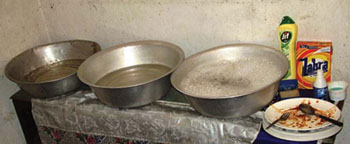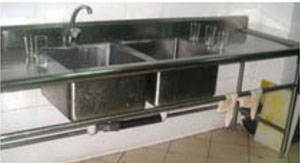11.3.8 Cleaning dishes, drinking utensils and cutlery
The cleaning of soiled dishes is an important way of preventing communicable diseases. There is an established procedure that the person who is the dish washer must follow. ‘Dish’ in this section includes plates, cups, glasses, spoons, forks and other utensils.
The three bowl method for cleaning soiled dishes
The manual cleaning process requires three vats or bowls, each with a capacity of 20–30 litres (Figure 11.4). Washing equipment such as detergent (powdered soap) and a scraping cloth, sponge or cleaning brushes are also necessary.

The procedure shown in Box 11.1 uses the three bowl system, which is recommended for the rural setting where running water is unlikely to be available.
Box 11.1 Dishcleaning guidelines where there is no running water
- Decide what to wash first: generally it is best to start with glasses and cups. However, the following description is for washing soiled plates.
- Fill the first two bowls halfway with warm water (50ºC). Hot water (80ºC or above) is added to the third bowl. A detergent must be included in the first bowl.
- Scrape the food from dish surfaces and collect it in a garbage container. Place the dish in the first bowl and wash with the detergent until the grease has gone. Washing plate by plate increases cleaning efficiency. Then place the washed item into the second bowl.
- Rinse the dish well in the second bowl. Any remaining food particles and soap must be taken away by thorough rinsing. Then place the dish into the third bowl.
- The process of dish washing in the third bowl is called sanitising which is a procedure to inactivate and remove the microorganisms that may be found on the surface of the dish. Sanitising is possible by rinsing the dish in hot water at a temperature of 80ºC for one to two minutes. Rinsing in warm water that contains chlorine (50–100 ppm) can replace the use of hot water. Immersing the rinsed dish for 15 seconds adequately sanitises.
- Dry the dish with a clean cloth or air-dry it. The cleaned and dried dish is then placed in a shelf or rack that has a cover. Dishes must be kept under cover until used. Remove dishes that are not in good condition and replace them with new ones.
- The water used for washing must be changed frequently as needed. The used water in the first bowl is more frequently changed than that in the second bowl. Continued use of dirty water must not be encouraged. The water temperature in the third bowl must be kept high.
Note that ppm stands for parts per million. It is a measure of the concentration of a substance in a solution.
Washing cups, glasses and spoons
The principle of cup washing is the same as that of washing soiled dishes. The three bowl system should be encouraged but two bowls is also acceptable, with warm water and detergent in the first bowl and hot water in the second. The first wash cleanses the grease, while the second bowl sanitises the cups. Cups must be dried with a clean piece of cloth or air-dried before use.
The glass-washing facilities for birle in tej bet should use a three bowl system. The first is used for washing with detergent, the second and third for rinsing.
When cold and hot running tap water is available, sinks with two compartments/bowls are sufficient because the hot running water is used for rinsing and sanitising (Figure 11.5).

11.3.7 Kitchen and food preparation site
